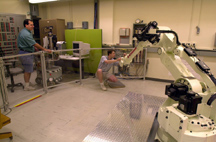 Purdue News
Purdue News
 Purdue News
Purdue News

|
|
November 2000 Careers in robotics explode through innovation
|

|
"There will always be an abundance of job opportunities in this field, because robots merely represent advanced automation," says Avi Kak, a Purdue professor of electrical and computer engineering. "We're working now on how to make robots smarter by putting sensors and cameras on them so they can 'see' and develop a memory."
In some of these projects, robots develop competence in much the same way a baby learns about objects and people — by looking at the individual or object and storing the image in a long-term memory.
"This is a topic in much science fiction, but in many ways it is a reality," Kak says. "The technology is here for robots to do household chores such as vacuuming, but it is not economically feasible yet. However, I can foresee this becoming available in our lifetime."
Those choosing to major in the robotics field will find career options in nearly every industry.
"A person could go into almost any industry," says Andrew Jones, a doctoral student in electrical and computer engineering. "I've had numerous offers from the automotive industry, but there are also the fields of electronics, agriculture and construction. Really, I can't think of any fields that do not use some sort of robotics, and their use can do nothing but grow."
Jones, of Austin, Texas, currently works with Guilherme DeSouza, a Purdue doctoral student from Brazil, and Youngrock Yoon, another Purdue doctoral student from Korea, on a Kawasaki UX120 robot, which was a gift to Purdue from the Ford Motor Co.
"This robot is used in automotive factories, but what we're trying to do with it is teach it to identify tires and wheel hubs so it can select and put the right tire with the right wheel hub," Jones says. "Basically we're teaching it to work 'on the fly' the way people can."
The process includes attaching three cameras at different angles to the robot and then programming the machine to "learn by showing."
"It's a form of artificial intelligence," Jones says. "This is accomplished by giving the robot eyes to see the parts and then a memory to recognize those parts."
This process can be adapted to numerous industries.
"There are endless applications for this type of robot," DeSouza says. "A robot could be trained to recognize hazardous waste containers and used to haul those containers from one location to another. This would reduce the risk to people working in this industry because they could move the materials without ever having to handle the product."
Other experimental robots include a "vision control" robot, which is being taught to recognize various objects in a room and thus learn about those items, and a roving robot called Peter, which uses cameras and sensors to navigate the through the halls and rooms of Purdue's electrical and computer engineering building.
Purdue's School of Electrical and Computer Engineering has several laboratories for robotics study including the Robot Vision Laboratory and the Articulated Motion Laboratory. A number of robotics courses are offered at the undergraduate level, such as electromechanical motor devices, and graduate level as well, including artificial intelligence and introduction to robotics systems.
Graduates this May with a bachelor's degree in electrical and computer engineering received an average salary of about $52,000, and those receiving a master's degree received an average salary of $63,000. Doctoral graduates can earn upwards of $100,000.
"There are so many choices within the field of robotics, I think anyone entering this field would have their choice of where and with what they would like to work," Jones says. "The development in this field is just phenomenal. I can see robots becoming more and more a part of our daily lives. Certainly industry continues to use robots at a growing rate, and our graduates receive multiple job offers. We could place many more individuals than we graduate."
Concerns that robots will replace individuals in the workplace are unfounded, Kak says.
"Robots support the workplace, and are typically given tasks that are physically strenuous to people such as lifting heavy car parts, or doing tasks that present safety issues for the workers, such as cleaning up hazardous waste," he says.
Kak encourages those interested in this field to study math and develop creative skills at a young age.
"A good way to develop those skills at a young age is through the use of tinker toys, erector sets, any of those toys that promote creativity and innovation," Kak says. "Having a natural desire to create and learn is important as well."
Sources: Avi Kak, (765) 494-3551, kak@purdue.edu
Andrew Jones, (765) 494-3454, ajones@ecn.purdue.edu
Writer: Sharon A. Bowker, (765) 494-9723, sbowker@purdue.edu
Other sources: Guilherme DeSouza, (765) 494-3502, gnelson@purdue.edu
PHOTO CAPTION:
Purdue University School of Electrical and Computer Engineering doctoral students Guilherme DeSouza of Brazil and Andrew Jones of Austin, Texas, work with a Kawasaki UX120 robot, given to Purdue by Ford Motor Co. The students' research could enable the machine to "see" and store memories for industrial use. (Purdue News Service Photo by David Umberger)
 To the Purdue News and Photos Page
To the Purdue News and Photos Page